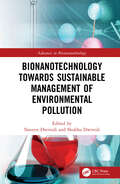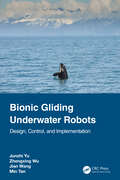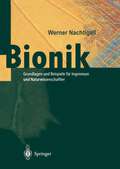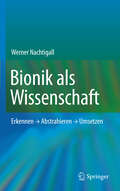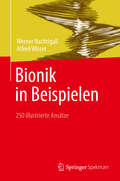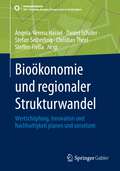- Table View
- List View
Bionanotechnology Towards Green Energy: Innovative and Sustainable Approach (Advances in Bionanotechnology)
by Shubha Dwivedi and Naveen DwivediBionanotechnology Towards Green Energy explains the role of bionanotechnology in the next generation technologies of green energy from an interdisciplinary and sustainability perspective. Chapters cover different roles of bionanotechnology such as applications of bio-nano enabled materials/coatings, scaling-up of green energy production, design and synthesis of bio-inspired nanomaterials and their applications, bio-nanofluid-based photovoltaic thermal systems, the use of bio-templated and biomimetic materials, and so forth. It focuses on waste-to-energy conversion and fixing intricate environmental issues. Key features: Provides detailed coverage of green energy production through bionanotechnological intervention Reviews future research needs in bionanotechnology in the green energy sector and scientific challenges in the mitigation of energy crises Deals with cutting-edge research on microbial synergism in biohydrogen production and storage Discusses the fabrication of bio-nano/hybrid electrode materials for supercapacitors and energy storage devices Includes extensive illustrations, case studies, summary tables, and up-to-date references This book is aimed at researchers and professionals in bionanotechnology, energy sciences, and environmental engineering.
Bionanotechnology Towards Sustainable Management of Environmental Pollution (Advances in Bionanotechnology)
by Naveen Dwivedi Shubha DwivediThis book highlights the characteristics, aims, and applications of bionanotechnology as a possible solution for sustainable management and bioremediation of environmental pollutants. It covers remediation of toxic pollutants, removal of emerging contaminants from industrial wastewater, eco-design and modification study of bio-nanoparticles and life-cycle assessment, nano-filtration, bio-nanomaterials based sensors for monitoring air and water pollution, resource recovery from wastewater, and highlights Internet of things-based green nanotechnology.Provides a comprehensive solution of environmental problems in sustainable and cost-effective modeReviews bionanotechnological applications in nanomaterials design, modification, and treatment of emerging contaminants from industrial wastewater.Covers Eco-design study of bio-nanomaterials, bio-nano filters, and assessment for the treatment of emerging pollutantsIncludes IoT- based bionanotechnologyExplores future research needs on bionanotechnology and scientific challenges in the mitigation of environmental pollutantsThis book is aimed at researchers, professionals, and graduate students in nanobiotechnology, environmental engineering, biotechnology.
Bionanotechnology Towards Sustainable Management of Environmental Pollution (Advances in Bionanotechnology)
by Naveen Dwivedi Shubha DwivediThis book highlights the characteristics, aims, and applications of bionanotechnology as a possible solution for sustainable management and bioremediation of environmental pollutants. It covers remediation of toxic pollutants, removal of emerging contaminants from industrial wastewater, eco-design and modification study of bio-nanoparticles and life-cycle assessment, nano-filtration, bio-nanomaterials based sensors for monitoring air and water pollution, resource recovery from wastewater, and highlights Internet of things-based green nanotechnology.Provides a comprehensive solution of environmental problems in sustainable and cost-effective modeReviews bionanotechnological applications in nanomaterials design, modification, and treatment of emerging contaminants from industrial wastewater.Covers Eco-design study of bio-nanomaterials, bio-nano filters, and assessment for the treatment of emerging pollutantsIncludes IoT- based bionanotechnologyExplores future research needs on bionanotechnology and scientific challenges in the mitigation of environmental pollutantsThis book is aimed at researchers, professionals, and graduate students in nanobiotechnology, environmental engineering, biotechnology.
Bionic Functional Structures by Femtosecond Laser Micro/nanofabrication Technologies (Springer Theses)
by Guoqiang LiThis thesis combines advanced femtosecond laser micro/nanofabrication technologies and frontier bionic design principles to prepare diverse biomimetic micro/nanostructures to realize their functions. By studying the formation mechanism of the micro/nanostructures, the author identifies various artificial structural colors, three-dimensional micro/nanocage arrays, and fish-scale inspired microcone arrays in different processing environments. Multiple functions such as enhanced antireflection, hydrophobicity, and underwater superoleophobicity are achieved by precisely adjusting laser-machining parameters. This novel design and method have extensive potential applications in the context of new colorizing technologies, microfluidics, microsensors, and biomedicine.
Bionic Gliding Underwater Robots: Design, Control, and Implementation
by Junzhi Yu Zhengxing Wu Jian Wang Min TanUnderwater robots play a significant role in ocean exploration. This book provides full coverage of the theoretical and practical aspects of bionic gliding underwater robots, including system design, modeling control, and motion planning. To overcome the inherent shortcomings of traditional underwater robots that can simultaneously lack maneuverability and endurance, a new type of robot, the bionic gliding underwater robot, has attracted much attention from scientists and engineers. On the one hand, by imitating the appearance and swimming mechanisms of natural creatures, bionic gliding underwater robots achieve high maneuverability, swimming efficiency, and strong concealment. On the other hand, borrowing from the buoyancy adjustment systems of underwater gliders, bionic gliding underwater robots can obtain strong endurance, which is significant in practical applications. Taking gliding robotic dolphin and fish as examples, the designed prototypes and proposed methods are discussed, offering valuable insights into the development of next-generation underwater robots that are well suited for various oceanic applications. This book will be of great interest to students and professionals alike in the field of robotics or intelligent control. It will also be a great reference for engineers or technicians who deal with the development of underwater robots.
Bionic Gliding Underwater Robots: Design, Control, and Implementation
by Junzhi Yu Zhengxing Wu Jian Wang Min TanUnderwater robots play a significant role in ocean exploration. This book provides full coverage of the theoretical and practical aspects of bionic gliding underwater robots, including system design, modeling control, and motion planning. To overcome the inherent shortcomings of traditional underwater robots that can simultaneously lack maneuverability and endurance, a new type of robot, the bionic gliding underwater robot, has attracted much attention from scientists and engineers. On the one hand, by imitating the appearance and swimming mechanisms of natural creatures, bionic gliding underwater robots achieve high maneuverability, swimming efficiency, and strong concealment. On the other hand, borrowing from the buoyancy adjustment systems of underwater gliders, bionic gliding underwater robots can obtain strong endurance, which is significant in practical applications. Taking gliding robotic dolphin and fish as examples, the designed prototypes and proposed methods are discussed, offering valuable insights into the development of next-generation underwater robots that are well suited for various oceanic applications. This book will be of great interest to students and professionals alike in the field of robotics or intelligent control. It will also be a great reference for engineers or technicians who deal with the development of underwater robots.
The Bionic Human: Health Promotion for People with Implanted Prosthetic Devices
by Frank E. Johnson Katherine S. VirgoAn integrated survey of best practices for the management of patients with implanted prosthetic devices and an insightful examination of the epidemiological, societal, and policy issues associated with their use. The devices covered range from breast, penile, vascular, and joint prostheses to cochlear, ossicular, and dental implants, and include cerebrospinal fluid shunts, cardiac valves, stents, and pacemakers. For each device, the authors consider its pros and cons, detail the best current strategies to keep implanted patients healthy, and evaluate the latest and most promising new diagnostic tests, Clinical counterpoints from distinguished authorities at major centers in the United States and Europe are offered throughout. Follow-up recommendations are summarized in a standardized format that allows comparative analysis and lays the foundation for controlled clinical trials and the eventual establishment of evidence-based guidelines.
Bionic Optimization in Structural Design: Stochastically Based Methods to Improve the Performance of Parts and Assemblies
by Rolf Steinbuch Simon GekelerThe book provides suggestions on how to start using bionic optimization methods, including pseudo-code examples of each of the important approaches and outlines of how to improve them. The most efficient methods for accelerating the studies are discussed. These include the selection of size and generations of a study’s parameters, modification of these driving parameters, switching to gradient methods when approaching local maxima, and the use of parallel working hardware.Bionic Optimization means finding the best solution to a problem using methods found in nature. As Evolutionary Strategies and Particle Swarm Optimization seem to be the most important methods for structural optimization, we primarily focus on them. Other methods such as neural nets or ant colonies are more suited to control or process studies, so their basic ideas are outlined in order to motivate readers to start using them.A set of sample applications shows how Bionic Optimization works in practice. From academic studies on simple frames made of rods to earthquake-resistant buildings, readers follow the lessons learned, difficulties encountered and effective strategies for overcoming them. For the problem of tuned mass dampers, which play an important role in dynamic control, changing the goal and restrictions paves the way for Multi-Objective-Optimization. As most structural designers today use commercial software such as FE-Codes or CAE systems with integrated simulation modules, ways of integrating Bionic Optimization into these software packages are outlined and examples of typical systems and typical optimization approaches are presented.The closing section focuses on an overview and outlook on reliable and robust as well as on Multi-Objective-Optimization, including discussions of current and upcoming research topics in the field concerning a unified theory for handling stochastic design processes.
Bionic Sensing with Artificial Lateral Line Systems for Fish-Like Underwater Robots
by Guangming Xie Xingwen ZhengIn this book, the authors first introduce two fish-like underwater robots, including a multiple fins-actuated robotic fish and a caudal fin-actuated robotic fish with a barycenter regulating mechanism. They study how a robotic fish uses its onboard pressure sensor arrays based-ALLS to estimate its trajectory in multiple locomotions, including rectilinear motion, turning motion, ascending motion, and spiral motion. In addition, they also explore the ALLS-based relative position and attitude perception between two robotic fish in a leader-follower formation. Four regression methods—multiple linear regression methods, support vector regressions, back propagation neural networks, and random forest methods—are used to evaluate the relative positions or attitudes using the ALLS data. The research on ALLS-based local sensing between two adjacent fish robots extends current research from one individual underwater robot to two robots in formation, and will attract increasing attention from scholars of robotics, underwater technology, biomechanics and systems, and control engineering.
Bionic Sensing with Artificial Lateral Line Systems for Fish-Like Underwater Robots
by Guangming Xie Xingwen ZhengIn this book, the authors first introduce two fish-like underwater robots, including a multiple fins-actuated robotic fish and a caudal fin-actuated robotic fish with a barycenter regulating mechanism. They study how a robotic fish uses its onboard pressure sensor arrays based-ALLS to estimate its trajectory in multiple locomotions, including rectilinear motion, turning motion, ascending motion, and spiral motion. In addition, they also explore the ALLS-based relative position and attitude perception between two robotic fish in a leader-follower formation. Four regression methods—multiple linear regression methods, support vector regressions, back propagation neural networks, and random forest methods—are used to evaluate the relative positions or attitudes using the ALLS data. The research on ALLS-based local sensing between two adjacent fish robots extends current research from one individual underwater robot to two robots in formation, and will attract increasing attention from scholars of robotics, underwater technology, biomechanics and systems, and control engineering.
Bionics by Examples: 250 Scenarios from Classical to Modern Times
by Werner Nachtigall Alfred WisserBionics means learning from the nature for the development of technology. The science of "bionics" itself is classified into several sections, from materials and structures over procedures and processes until evolution and optimization. Not all these areas, or only a few, are really known in the public and also in scientific literature. This includes the Lotus-effect, converted to the contamination-reduction of fassades and the shark-shed-effect, converted to the resistance-reduction of airplanes. However, there are hundreds of highly interesting examples that contain the transformation of principles of the nature into technology. From the large number of these examples, 250 were selected for the present book according to "prehistory", "early-history", "classic" and "modern time". Most examples are new. Every example includes a printed page in a homogeneous arrangement. The examples from the field "modern time" are joint in blocks corresponding to the sub-disciplines of bionics.
Bionik: Ökologische Technik nach dem Vorbild der Natur?
by Arnim Von GleichAls Begriff aus Biologie und Technik abgeleitet bezeichnet das Fachgebiet Bionik den Versuch, sich in der ingenieurwissenschaftlichen Forschung und beim konstruktiven Schaffen an evolutionär erprobten Strukturen, Funktionen und Strategien der Natur zu orientieren. Der Band Bionik gibt nicht nur einen Überblick über die Forschungsthemen und Probleme des an mehreren Universitäten vertretenen Faches, sondern informiert auch detailliert über die Arbeit zahlreicher Wissenschaftler, die sich in Deutschland mit der Übertragung und Anwendung von Entwicklungen der Natur auf Bereiche wie die Architektur, die Konstruktion von Schiffen, Fahrzeugen, Bauteilen und Maschinen oder auch die Verfahrens- Energie- und Klimatechnik beschäftigen.
Bionik: Grundlagen und Beispiele für Ingenieure und Naturwissenschaftler
by Werner NachtigallDieses umfassende Lehrbuch wendet sich an Studenten, Fachleute und Wissenschaftler und liegt somit im Niveau deutlich über den üblichen Sachbüchern zur Bionik. Es wird gezeigt, was Bionik ist, wie sie sich entwickelt hat, wie man Fragen stellt und was Bionik leisten kann. Im Detail diskutiert das Buch ausgewählte Beispiele aus den verschiedensten technologischen Bereichen. Es bietet auch einen Zugang zum wissenschaftlichen und gesellschaftlichen Umfeld der Bionik. Die vielfältigen Facetten dieser interdisziplinären Wissenschaft fügen sich in diesem anspruchsvollen Werk puzzleartig zu einer "Biostrategie in die Zukunft" zusammen. Seit dem Erscheinen der 1. Auflage hat sich die Bionik vielseitig weiterentwickelt. Das Buch wurde daher von Grund auf neu geschrieben, wobei einige bewährte Abschnitte beibehalten wurden. Der Umfang wurde verdoppelt, die Zahl der Beispiele vervierfacht.
Bionik: Grundlagen und Beispiele für Ingenieure und Naturwissenschaftler
by Werner NachtigallDieses umfassende Lehrbuch wendet sich an Studenten, Fachleute und Wissenschaftler und liegt somit im Niveau deutlich über den üblichen Sachbüchern zur Bionik. In einem umfangreichen allgemeinen Teil zeigt der Autor, was Bionik ist, wie sie sich entwickelt hat, wie man Fragen stellt und was Bionik leisten kann. Darauf folgen detaillierte Darstellungen von 40 ausgewählten Beispielen aus den verschiedensten technolgischen Bereichen. Die vielfältigen Facetten dieser interdisziplinären Wissenschaft fügen sich in diesem anspruchsvollen Werk puzzleartig zu einer "Biostrategie in die Zukunft" zusammen.
Bionik: Aktuelle Forschungsergebnisse in Natur-, Ingenieur- und Geisteswissenschaft
by Torsten Rossmann Cameron TropeaIn vielen Wissenschafts- und Technikzweigen ist der praktische Nutzen der Bionik anerkannt. Die Lösung technischer Probleme mit Hilfe biologisch motivierter Prinzipien wird erfolgreich praktiziert. Außen vor blieb jedoch bisher die Verständigung zwischen den beteiligten Wissenschaftszweigen.Dieses Buch gibt einen aktuellen Überblick über die unterschiedlichen Forschungsfelder, angefangen von Optimierungsstrategien in der Robotik über Adaptive Beinprothesen, Informationsverarbeitung in natürlichen und künstlichen Systemen, Optimierungsstrategien in der Industrie bis hin zu Philosophischen Aspekten der Bionik. Somit unterstützt es erstmals einen Diskurs zwischen den Disziplinen und ermöglicht einen Austausch zwischen Forschern unterschiedlicher Fachgebiete. Die Beiträge sind allgemein verständlich geschrieben und wagen einen Blick in die Zukunft spannender Forschungsaufgaben.
Bionik: Bionisches Konstruieren verstehen und anwenden
by Welf WawersDieses Lehrbuch erklärt anschaulich Anwendung aus der Bionik an zahlreichen Beispielen und vermittelt eine Vorgehensweise für die Identifizierung biologischer Lösungen und deren Übertragung auf technische Anwendungen. Basisinformationen der Biologie und Grundlagen der Konstruktionstechnik gewährleisten einen leichten Zugang zum Stoff. Mit dem 3D-Druck als Schlüsseltechnologie und der Thematisierung der Nachhaltigkeit geht das Buch zudem auf aktuelle Entwicklungen ein. Dieser ganzheitliche Blick soll den Leser zur Durchführung bionischer Projekte befähigen und motivieren.
Bionik als Wissenschaft: Erkennen - Abstrahieren - Umsetzen
by Werner NachtigallDer Begriff „BIONIK“ wird gerne als Kunstwort gekennzeichnet, zusammengesetzt aus BIOlogie und TechNIK. Bionik stellt einerseits ein Fach dar, in dem geforscht und ausgebildet wird, und kennzeichnet andererseits eine Sichtweise, nämlich die des „Lernens von der Natur für die Technik“. Darüber sind in der Zwischenzeit neben populär wissenschaftlichen Werken eine Reihe von Fachbüchern erschienen. Werner Nachtigall hat darin mit der 2. Auflage seines bei Springer erschienenen Buchs „BIONIK – Grundlagen und Beispiele für Ingenieure und Naturwissenschaftler“ einen Meilenstein gesetzt. In diesem Buch kennzeichnet er die Untergliederung des Fachs und bespricht detailliert dessen Forschungsgegenstände. Dagegen fehlte bislang eine Darstellung, die sich mit den erkenntnistheoretischen Grundlagen wie mit der pragmatischen Vorgehensweise der Bionik systematisch befasst, die ja mit der ihr eigenen Prinzip-Abstraktion zwischen der belebten Welt als Vor-Bild und der technischen Umsetzung als Ab-Bild vermitteln will. Das vorliegende Werk schließt diese Lücke mit drei großen Abschnitten: Biologische Basis: Erforschen, Beschreiben, Beurteilen. – Abstraktion biologischer Befunde: Herausarbeiten allgemeiner Prinzipien. – Umsetzung in die Technik: Prinzipvergleich, Konzeptuelles, Vorgehensweise.
Bionik in Beispielen: 250 illustrierte Ansätze
by Werner Nachtigall Alfred WisserBionik betreiben bedeutet, von der Natur für die Technik lernen. Die Wissenschaft „Bionik“ lässt sich in mehrere Teilgebiete untergliedern, von Materialien und Strukturen über Verfahren und Abläufe bis zu Evolution und Optimierung. Auf all diesen Gebieten gibt es bereits vielerlei Ansätze. In der Öffentlichkeit - und seltsamerweise auch in den naturwissenschaftlichen Fachdisziplinen - sind aber nur wenige wirklich bekannt. Dazu zählen der Lotus-Effekt, umgesetzt für die Verschmutzungsverminderung von Fassaden, und der Haischuppen-Effekt, umgesetzt für die Widerstandsreduzierung von Flugzeugen. Dabei gibt es aber heute schon hunderte von hochinteressanten Ansätzen, die eine Umsetzung von Naturprinzipien in die Technik zum Inhalt haben. Aus der Fülle dieser Ansätze sind für das vorliegende Buch 250 ausgewählt nach „Vorgeschichte“, „Frühgeschichte“, „Klassik“ und „Neuzeit“. Die meisten Beispiele sind neuerer Art. Jedes Beispiel umfasst in gleichartiger Gliederung eine Druckseite. Die Beispiele aus dem Bereich „Neuzeit“ sind in Blocks gegliedert, die den Unterdisziplinen der Bionik entsprechen.
Bioökonomie für Einsteiger
by Joachim Pietzsch Stephan Meyer Wolfgang Zettlmeier Ulrich SchurrDieses Buch bietet eine aktuelle und gut lesbare Einführung in die Bioökonomie. Es vermittelt damit grundlegende Kenntnisse zum Verständnis eines Transformationsprozesses, der das 21. Jahrhundert prägen wird und die Integration vieler Disziplinen und Branchen verlangt, die bisher wenig miteinander zu tun hatten. Die Rede ist von dem allmählichen und notwendigen Übergang aus dem Zeitalter fossiler Brennstoffe, das vor rund 200 Jahren begann, in eine weltweite Wirtschaftsform, die auf nachwachsenden Rohstoffen (und erneuerbaren Energien) basiert. Dieses Buch begreift die Verwirklichung von Bioökonomie(n) dabei als eine dreifache Herausforderung – eine naturwissenschaftliche, eine ökonomische und eine ökologische. Woher stammt die Biomasse, die wir vorrangig für die Ernährung der wachsenden Weltbevölkerung wie auch für eine zukünftige energetische und stoffliche Nutzung brauchen? Wie wird sie in Bioraffinerien verarbeitet und welche Rolle kommt der Biotechnologie zu? Welche Gesichtspunkte der Innovationsökonomie gilt es zu bedenken, welche betriebswirtschaftlichen Aspekte der Wertschöpfung, Wettbewerbsfähigkeit und Kundenakzeptanz sind von Bedeutung? Welche Bedingungen muss die Bioökonomie erfüllen, um eine nachhaltige Entwicklung der Erde zu ermöglichen? Darf sie überhaupt auf Wachstumsziele setzen oder sollte sie sich nicht besser am Ideal der Suffizienz orientieren? Indem das Buch diese Fragen aus den nicht widerspruchsfreien Perspektiven ausgewiesener Experten behandelt, gibt es einen interdisziplinären Überblick über ein dynamisches Feld von Forschung und Praxis, der mehr Fragen aufwirft als beantwortet und dennoch eine Lücke schließt. Denn bisher gibt es keine verständliche und fachübergreifende Darstellung der Bioökonomie. Das macht die Lektüre dieses Buches zu einem Gewinn nicht nur für Einsteiger, sondern auch für Fachleute, die über die Grenzen ihres eigenen Fachgebietes hinausschauen wollen.
Bioökonomie im Selbststudium: Grundlagen und Ausgangspunkte (Zertifikatskurs Bioökonomie)
by Joachim PietzschDieses Studienheft ist ein Teil des Springer Zertikfikatskurses Bioökonomie und wird als Material zum Selbstlernen eingesetzt.Historische Einordnung | Entstehung des Begriffs Bioökonomie | Verschiedene politische Strategien der Bioökonomie| Bioökonomie und Nachhaltigkeit | Kaskadennutzung und Kreislaufwirtschaft| Profilierte Bioökonomie-Regionen in Deutschland | Gesetzliche Rahmenbedingungen | Die sieben Herausforderungen der Bioökonomie | Vorstellung beispielhafter Produkte | Fallstudien
Bioökonomie und regionaler Strukturwandel: Wertschöpfung, Innovation und Nachhaltigkeit planen und umsetzen (SDG - Forschung, Konzepte, Lösungsansätze zur Nachhaltigkeit)
by Angela-Verena Hassel Daniel Schiller Stefan Seiberling Christian Theel Steffen FleßaBioökonomie ist eine neue branchenübergreifende Form des Wirtschaftens, die das Potenzial hat, die bisherige Ökonomie und einzelne Regionen grundlegend zu verändern. Dieser Überzeugung folgend stellen die Herausgeber und Autoren dieses Buches den aktuellen Wissenstand aus Theorie und Praxis der Bioökonomie zusammen, entwickeln neue Methoden für einen bioökonomischen Strukturwandel und reflektieren bestehende Bioökonomiekonzepte. Der komplexe und vielschichtige Prozess einer pflanzenbasierten Bioökonomie in ländlichen Räumen wird aus unterschiedlichen Perspektiven betrachtet. Zunächst werden ökonomische Grundlagen sowohl aus gesamt- als auch aus einzelwirtschaftlicher Sicht diskutiert. Dem schließen sich Beispiele an, wie regionale Innovationsnetzwerke und Wertschöpfungsketten der Bioökonomie einen Beitrag zur nachhaltigen Regionalentwicklung und zum gesellschaftlichen Wandel leisten können. Die darauf aufbauende Analyse legt dar, wie verschiedene Akteure und Prozesse eine regionale Bioökonomie in der Praxis etablieren können. Ausgewählte Anwendungs- und Umsetzungsbeispiele für Innovationen pflanzenbasierter Bioökonomie im nordöstlichen Mecklenburg-Vorpommern runden das Buch ab und zeigen das Potenzial für eine Transformation der Wirtschaft in der Region und darüber hinaus.
Bioorganic Phase in Natural Food: An Overview
by S. Mohana Roopan G. MadhumithaThe focus of this singular work is to discuss the role and importance of bioorganic phase in food products-providing the first major reference source for researchers looking to understand all aspects of the isolation, extraction and application of this major element in natural foods. From the identifying features to its applications through biotechnology and nanobiotechnology, this book covers all of the important aspects of bioorganic phase and points to future uses and methods. With chapters focusing on phase extraction and application, food product synthesis and nanoparticle application, Bioorganic Phase in Natural Food: An Overview covers both conventional and non-conventional approaches for the extraction of bioorganic phase from various food sources. Toxicity studies in nanoparticles are presented, and the vital role played by bioorganic phase toward nanoparticles synthesis is outlined in full. For any researcher looking for complete coverage of all main aspects of bioorganic phase in foods, this work provides a comprehensive and well-researched view of this important subject. .
Biopacemaking (Series in Biomedical Engineering)
by J. A. E Spaan Ruben Coronel Jacques M. T. De Bakker Antonio ZazaThe development of a bio-engineered pacemaker is of substantial clinical and also scientific interest because it promises to overcome several limitations of electronic pacemakers. Moreover it may answer the longstanding question of whether the complex structure of the sinus node is indeed a prerequisite for reliable pacemaking, or simpler structures might work as well. This book gives an overview of the current state-of-the-art of creating a bio-engineered pacemaker. It shows the approaches to develop of genetic and cell-based engineering methods suitable to implement them with safety and stability. It also illuminates the problems that need to be solved before bio-pacemaking can be considered for clinical use.
Biopackaging
by Martin A. MasuelliThis book examines the whole range of modern packaging options. It covers edible packaging based on carbohydrates, proteins, antioxidative and antimicrobial packaging, and the chemistry of food and food packaging, such as plasticization and polymer morphology. Issues related to shelf life and biodegradability are also discussed, in addition to newly discovered processing and preservation techniques, most notably modified atmosphere packaging (MAP) and active packaging (AP).

